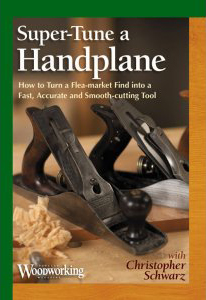
Chris Schwarz, Super-Tune a Handplane: DVD Review
by J. Norman Reid
Delaplane, VA
I teach a class on restoring old handplanes. I've read all the books and articles I could find on the subject. And, I've built up my own base of expertise by restoring a number of planes in my own shop. I thought I knew all there was to know about restoring and setting up planes. I was wrong, and this excellent DVD proved it.
In this newly-released 2 hour and 36 minute DVD, Chris Schwarz explores the whole issue of acquiring, restoring and setting up a Stanley Bailey-style handplane. He begins where he later ends, by considering the pros and cons of restoring an old plane versus buying a new one. If restoring a plane is your choice, he offers valuable guidance on what to look for and what to avoid when buying a suitable plane.
The bulk of the DVD is a demonstration in real time of all the steps to take a #4 Stanley Bailey plane from flea market bargain to high-performing user. Included are stripping and cleaning the parts, flattening the sole, adjusting and honing the chip breaker, sharpening the blade and reassembling the plane for smooth operation. Throughout, Schwarz provides valuable advice on how best to adjust the plane for maximum performance. One example: once the mouth opening has been set, screw down the frog screws very tightly; any movement in the frog predictably produces chatter of the blade on the wood's surface. Another example: level the blade's projection from the mouth with a slight hammer tap on the blade end; the lateral adjustment lever is too crude a device to deliver the subtle movements required for fine-tuning.
While most of his demonstration focuses on restoring the plane to full usability, the final sections on super fine-tuning will be valuable whether you are restoring an older plane or enhancing the performance of a newer premium model. Included are demonstrations of cambering the blade, rounding the blade's corners to reduce tracking, other tips to avoid tracking and similar marks, adding a back bevel (he uses a jig to set his back bevel at 10°) and setting the mouth for the thinnest shavings from his smoothing plane.
Though his demonstration exclusively focuses on a #4 smoother, the steps to restore a fore or jack plane and a jointer are similar. Mostly missing from the DVD, however, is discussion of how to set up those planes to achieve the different results you seek from them. But this merely conforms to his concluding advice: set up and super tune just one plane, the one you'll use the most, then continually work at improving its performance over time. Each time you refine its settings you'll advance its tuning another degree; as you do, you’ll learn more and more about how to enhance its responsiveness to your hands.
Is restoring an older Stanley the best path for you to take? Schwarz concludes that a Stanley’s lesser mass and stability will never give you the same degree of high performance as a newer premium plane based on the Stanley Bedrock model. But in the end, it comes down to a choice between your budget and your time and whether you will ever require that nth degree of added perfection premium planes promise. What Schwarz has proven is that in the space of a couple of hours, it's within the capabilities of us all to bring a bargain to a place of near perfection. And sometimes, good enough is good enough.
Purchase your own copy of
Super-Tune a Handplane
The author is a woodworker, writer and photographer living in Delaplane, Virginia, in the
foothills of the Blue Ridge Mountains with his wife, four cats and a woodshop full of
power and hand tools.
He can be reached by email at
nreid@fcc.net
.
Return to
Wood News
front page


